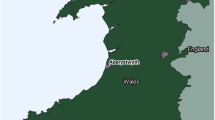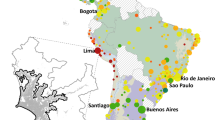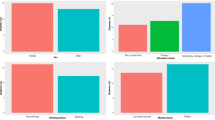Abstract
Background
The Normalized Difference Vegetation Index (NDVI) is a measure of greenness widely used in environmental health research. High spatial resolution NDVI has become increasingly available; however, the implications of its use in exposure assessment are not well understood.
Objective
To quantify the impact of NDVI spatial resolution on greenness exposure misclassification.
Methods
Greenness exposure was assessed for 31,328 children in the Greater Boston Area in 2016 using NDVI from MODIS (250 m2), Landsat 8 (30 m2), Sentinel-2 (10 m2), and the National Agricultural Imagery Program (NAIP, 1 m2). We compared continuous and categorical greenness estimates for multiple buffer sizes under a reliability assessment framework. Exposure misclassification was evaluated using NAIP data as reference.
Results
Greenness estimates were greater for coarser resolution NDVI, but exposure distributions were similar. Continuous estimates showed poor agreement and high consistency, while agreement in categorical estimates ranged from poor to strong. Exposure misclassification was higher with greater differences in resolution, smaller buffers, and greater number of exposure quantiles. The proportion of participants changing greenness quantiles was higher for MODIS (11–60%), followed by Landsat 8 (6–44%), and Sentinel-2 (5–33%).
Significance
Greenness exposure assessment is sensitive to spatial resolution of NDVI, aggregation area, and number of exposure quantiles. Greenness exposure decisions should ponder relevant pathways for specific health outcomes and operational considerations.

This is a preview of subscription content, access via your institution
Access options
Subscribe to this journal
Receive 6 print issues and online access
$259.00 per year
only $43.17 per issue
Buy this article
- Purchase on Springer Link
- Instant access to full article PDF
Prices may be subject to local taxes which are calculated during checkout






Similar content being viewed by others
Data availability
Greenness data generated in this study are available from the corresponding author upon reasonable request.
References
Twohig-Bennett C, Jones A. The health benefits of the great outdoors: a systematic review and meta-analysis of greenspace exposure and health outcomes. Environ Res. 2018;166:628–37.
La Fortezza R, Carrus G, Sanesi G, Davies C. Benefits and well-being perceived by people visiting green spaces in periods of heat stress. Urban Urban Green. 2009;8:97–108.
Escobedo FJ, Kroeger T, Wagner JE. Urban forests and pollution mitigation: analyzing ecosystem services and disservices. Environ Pollut. 2011;159:2078–87.
Douglas I. Urban ecology and urban ecosystems: understanding the links to human health and well-being. Curr Opin Environ Sustain. 2012;4:385–92.
Diener A, Mudu P. How can vegetation protect us from air pollution? A critical review on green spaces’ mitigation abilities for air-borne particles from a public health perspective - with implications for urban planning. Sci Total Environ. 2021;796:148605.
Grote R, Samson R, Alonso R, Amorim JH, Cariñanos P, Churkina G, et al. Functional traits of urban trees: air pollution mitigation potential. Front Ecol Environ. 2016;14:543–50.
Dzhambov A, Dimitrova D. Urban green spaces′ effectiveness as a psychological buffer for the negative health impact of noise pollution: a systematic review. Noise Heal. 2014;16:157.
Bolund P, Hunhammar S. Ecosystem services in urban areas. Ecol Econ. 1999;29:293–301.
Kong L, Lau KK-L, Yuan C, Chen Y, Xu Y, Ren C, et al. Regulation of outdoor thermal comfort by trees in Hong Kong. Sustain Cities Soc. 2017;31:12–25.
van den Berg M, Wendel-Vos W, van Poppel M, Kemper H, van Mechelen W, Maas J. Health benefits of green spaces in the living environment: a systematic review of epidemiological studies. Urban For Urban Green. 2015;14:806–16.
Gascon M, Triguero-Mas M, Martínez D, Dadvand P, Forns J, Plasència A, et al. Mental health benefits of long-term exposure to residential green and blue spaces: a systematic review. Int J Environ Res Public Health. 2015;12:4354–79.
Crouse DL, Pinault L, Balram A, Hystad P, Peters PA, Chen H, et al. Urban greenness and mortality in Canada’s largest cities: a national cohort study. Lancet Planet Heal. 2017;1:e289–97.
Orioli R, Antonucci C, Scortichini M, Cerza F, Marando F, Ancona C, et al. Exposure to residential greenness as a predictor of cause-specific mortality and stroke incidence in the Rome longitudinal study. Environ Health Perspect. 2019;127:027002.
Vienneau D, de Hoogh K, Faeh D, Kaufmann M, Wunderli JM, Röösli M. More than clean air and tranquillity: residential green is independently associated with decreasing mortality. Environ Int. 2017;108:176–84.
McCormick R. Does access to green space impact the mental well-being of children: a systematic review. J Pediatr Nurs. 2017;37:3–7.
Cusack L, Larkin A, Carozza SE, Hystad P. Associations between multiple green space measures and birth weight across two US cities. Health Place. 2017;47:36–43.
Hu CY, Yang XJ, Gui SY, Ding K, Huang K, Fang Y, et al. Residential greenness and birth outcomes: a systematic review and meta-analysis of observational studies. Environ Res. 2021;193:110599.
Dadvand P, Sunyer J, Basagaña X, Ballester F, Lertxundi A, Fernández-Somoano A, et al. Surrounding greenness and pregnancy outcomes in four Spanish birth cohorts. Environ Health Perspect. 2012;120:1481–7.
Browning MHEM, Kuo M, Sachdeva S, Lee K, Westphal L. Greenness and school-wide test scores are not always positively associated –a replication of “linking student performance in Massachusetts elementary schools with the ‘greenness’ of school surroundings using remote sensing. Landsc Urban Plan. 2018;178:69–72.
Wing TVL, Tuen YTT, Wen-Chi P, Wu C-D, Shih-Chun CL, Spengler JD. How is environmental greenness related to students’ academic performance in English and Mathematics? Landsc Urban Plan. 2019;181:118–24.
Thiering E, Markevych I, Brüske I, Fuertes E, Kratzsch J, Sugiri D, et al. Associations of residential long-term air pollution exposures and satellite-derived greenness with insulin Resistance in German Adolescents. Environ Health Perspect. 2016;124:1291–8.
Hodson CB, Sander HA. Relationships between vegetation in student environments and academic achievement across the continental U.S. Landsc Urban Plan. 2019;189:212–24.
Lambert KA, Bowatte G, Tham R, Lodge C, Prendergast L, Heinrich J, et al. Residential greenness and allergic respiratory diseases in children and adolescents – a systematic review and meta-analysis. Environ Res. 2017;159:212–21.
Gernes R, Brokamp C, Rice GE, Wright JM, Kondo MC, Michael YL, et al. Using high-resolution residential greenspace measures in an urban environment to assess risks of allergy outcomes in children. Sci Total Environ. 2019;668:760–7.
Andrusaityte S, Grazuleviciene R, Kudzyte J, Bernotiene A, Dedele A, Nieuwenhuijsen MJ. Associations between neighbourhood greenness and asthma in preschool children in Kaunas, Lithuania: a case-control study. BMJ Open. 2016;6.4:e010341.
Labib SM, Lindley S, Huck JJ. Spatial dimensions of the influence of urban green-blue spaces on human health: a systematic review. Environ Res. 2020;180:108869.
Markevych I, Schoierer J, Hartig T, Chudnovsky A, Hystad P, Dzhambov AM, et al. Exploring pathways linking greenspace to health: theoretical and methodological guidance. Environ Res. 2017;158:301–17.
Cusack L, Larkin A, Carozza S, Hystad P. Associations between residential greenness and birth outcomes across Texas. Environ Res. 2017;152:88–95.
Fong KC, Hart JE, James P. A review of epidemiologic studies on greenness and health: updated literature through 2017. Curr Environ Heal Rep. 2018;5:77–87.
Zhan Y, Liu J, Lu Z, Yue H, Zhang J, Jiang Y. Influence of residential greenness on adverse pregnancy outcomes: a systematic review and dose-response meta-analysis. Sci. Total Environ. 2020;718:137420.
Rhew IC, Vander Stoep A, Kearney A, Smith NL, Dunbar MD. Validation of the normalized difference vegetation index as a measure of neighborhood greenness. Ann Epidemiol. 2011;21:946–52.
Gascon M, Triguero-Mas M, Martínez D, Dadvand P, Rojas-Rueda D, Plasència A, et al. Residential green spaces and mortality: a systematic review. Environ Int. 2016;86:60–7.
Shahtahmassebi AR, Li C, Fan Y, Wu Y, lin Y, Gan M, et al. Remote sensing of urban green spaces: a review. Urban For Urban Green 2021;57:126946.
Badgley G, Field CB, Berry JA. Canopy near-infrared reflectance and terrestrial photosynthesis. Sci Adv. 2017;3:e1602244.
Jiang Z, Chen Y, Li J, Dou W. The impact of spatial resolution on NDVI over heterogeneous surface. In: International Geoscience and Remote Sensing Symposium (IGARSS). 2005. 1310–3.
Jiang Z, Huete AR, Chen J, Chen Y, Li J, Yan G, et al. Analysis of NDVI and scaled difference vegetation index retrievals of vegetation fraction. Remote Sens Environ. 2006;101:366–78.
Chen X, Wang D, Chen J, Wang C, Shen M. The mixed pixel effect in land surface phenology: a simulation study. Remote Sens Environ. 2018;211:338–44.
Sun Y, Meng Q, Sun Z, Zhang J, Zhang L. Assessing the impacts of grain sizes on landscape pattern of urban green space. Proc. SPIE 10462, AOPC 2017: Optical Sensing and Imaging Technology and Applications, 2017;104623J. https://doi.org/10.1117/12.2285177.
Small C. A global analysis of urban reflectance. Int J Remote Sens. 2005;26:661–81.
Nouri H, Anderson S, Sutton P, Beecham S, Nagler P, Jarchow CJ, et al. NDVI, scale invariance and the modifiable areal unit problem: an assessment of vegetation in the Adelaide Parklands. Sci Total Environ. 2017;584–585:11–8.
Grazuleviciene R, Danileviciute A, Dedele A, Vencloviene J, Andrusaityte S, Uždanaviciute I, et al. Surrounding greenness, proximity to city parks and pregnancy outcomes in Kaunas cohort study. Int J Hyg Environ Health. 2015;218:358–65.
Dadvand P, de Nazelle A, Figueras F, Basagaña X, Su J, Amoly E, et al. Green space, health inequality and pregnancy. Environ Int. 2012;40:110–5.
Nordbø ECA, Nordh H, Raanaas RK, Aamodt G. GIS-derived measures of the built environment determinants of mental health and activity participation in childhood and adolescence: a systematic review. Landscape Urban Plan. 2018;177:19–37.
Browning MHEM, Lee K. Within what distance does greenness best predict physical health? A systematic review of articles with GIS buffer analyses across the lifespan. Int J Environ Res Public Health. 2017;14.7:675.
Su JG, Dadvand P, Nieuwenhuijsen MJ, Bartoll X, Jerrett M. Associations of green space metrics with health and behavior outcomes at different buffer sizes and remote sensing sensor resolutions. Environ Int. 2019;126:162–70.
Reid CE, Kubzansky LD, Li J, Shmool JL, Clougherty JE. It’s not easy assessing greenness: a comparison of NDVI datasets and neighborhood types and their associations with self-rated health in New York City. Health Place. 2018;54:92–101.
Browning MHEM, Locke DH. The greenspace-academic performance link varies by remote sensing measure and urbanicity around Maryland public schools. Landsc Urban Plan. 2020;195:103706.
Labib SM, Lindley S, Huck JJ. Scale effects in remotely sensed greenspace metrics and how to mitigate them for environmental health exposure assessment. Comput Environ Urban Syst. 2020;82:101501.
MassGIS (Massachusetts Bureau of Geographic Information). MassGIS Data: Master Address Data - Basic Address Points. 2021. https://docs.digital.mass.gov/dataset/massgis-data-master-address-data-basic-address-points.
ESRI. ArcMap v10.7. Redlands, CA; ESRI: 2019.
Didan K. MOD13Q1 MODIS/Terra Vegetation Indices 16-Day L3 Global 250m SIN Grid V006. NASA EOSDIS Land Processes DAAC 10. 2015.
U.S. Department of Agriculture. NAIP Imagery. 2021. https://www.fsa.usda.gov/programs-and-services/aerial-photography/imagery-programs/naip-imagery/index.
National Agricultural Imagery Program (NAIP). 2016 Massachusetts NAIP Imagery. USDA FSA Aerial Photography Field Office; National Agricultural Imagery Program (NAIP); Salt Lake City, Utah. Unites States of America; 2019.
Gorelick N, Hancher M, Dixon M, Ilyushchenko S, Thau D, Moore R. Google Earth Engine: planetary-scale geospatial analysis for everyone. Remote Sens Environ. 2017;202:18–27.
Liu J, Tang W, Chen G, Lu Y, Feng C, Ty XM. Correlation and agreement: overview and clarification of competing concepts and measures. Shanghai Arch Psychiatry. 2016;28:115.
Shrout PE, Fleiss JL. Intraclass correlations: Uses in assessing rater reliability. Psychol Bull. 1979;86:420–8.
McGraw KO, Wong SP. Forming inferences about some intraclass correlation coefficients. Psychol Methods. 1996;1:30–46.
McHugh ML. Interrater reliability: the kappa statistic. Biochem Med. 2012;22:276–82.
Cohen J. A coefficient of agreement for nominal scales. Educ Psychol Meas. 1960;20:37–46.
Li D, Sullivan WC. Impact of views to school landscapes on recovery from stress and mental fatigue. Landsc Urban Plan. 2016;148:149–58.
Pun VC, Manjourides J, Suh HH. Association of neighborhood greenness with self-perceived stress, depression and anxiety symptoms in older U.S adults. Environ Heal. 2018;17:1–11.
Jelinski DE, Wu J. The modifiable areal unit problem and implications for landscape ecology. Landsc Ecol. 1996;11:129–40.
Helbich M. Spatiotemporal contextual uncertainties in green space exposure measures: exploring a time series of the normalized difference vegetation indices. Int J Environ Res Public Heal. 2019;16:852.
Houston D. Implications of the modifiable areal unit problem for assessing built environment correlates of moderate and vigorous physical activity. Appl Geogr. 2014;50:40–7.
Tsai W-L, Leung Y-F, McHale MR, Floyd MF, Reich BJ. Relationships between urban green land cover and human health at different spatial resolutions. Urban Ecosyst. 2019;22:315–24.
Gascon M, Cirach M, Martínez D, Dadvand P, Valentín A, Plasència A, et al. Normalized difference vegetation index (NDVI) as a marker of surrounding greenness in epidemiological studies: the case of Barcelona city. Urban For Urban Green. 2016;19:88–94.
Sadeh M, Brauer M, Dankner R, Fulman N, Chudnovsky A. Remote sensing metrics to assess exposure to residential greenness in epidemiological studies: a population case study from the Eastern Mediterranean. Environ Int. 2021;146:106270.
Rugel EJ, Henderson SB, Carpiano RM, Brauer M. Beyond the Normalized Difference Vegetation Index (NDVI): Developing a Natural Space Index for population-level health research. Environ Res. 2017;159:474–83.
Mavoa S, Lucassen M, Denny S, Utter J, Clark T, Smith M. Natural neighbourhood environments and the emotional health of urban New Zealand adolescents. Landsc Urban Plan. 2019;191:103638.
Hipp JA, Gulwadi GB, Alves S, Sequeira S. The relationship between perceived greenness and perceived restorativeness of university campuses and student-reported quality of life. Environment and Behavior. 2016;48:1292–308.
Tilt JH, Unfried TM, Roca B. Using objective and subjective measures of neighborhood greenness and accessible destinations for understanding walking trips and BMI in Seattle, Washington. American Journal of Health Promotion. 2007;21:371–9.
Loder AKF, Gspurning J, Paier C, Poppel van MNM. Objective and perceived neighborhood greenness of students differ in their agreement in home and study environments. Int J Environ Res Public Heal 2020. 2020;17:3427.
Kang Y, Zhang F, Gao S, Lin H, Liu Y. A review of urban physical environment sensing using street view imagery in public health studies. Annals of GIS. 2020;26:261–75.
Larkin A, Hystad P. Evaluating street view exposure measures of visible green space for health research. J Expo Sci Environ Epidemiol. 2018;29:447–56.
Lu Y, Yang Y, Sun G, Gou Z. Associations between overhead-view and eye-level urban greenness and cycling behaviors. Cities. 2019;88:10–8.
Helbich M, Poppe R, Oberski D, Zeylmans van Emmichoven M, Schram R. Can’t see the wood for the trees? An assessment of street view- and satellite-derived greenness measures in relation to mental health. Landsc Urban Plan. 2021;214:104181.
Wang R, Feng Z, Pearce J, Yao Y, Li X, Liu Y. The distribution of greenspace quantity and quality and their association with neighbourhood socioeconomic conditions in Guangzhou, China: a new approach using deep learning method and street view images. Sustain Cities Soc. 2021;66:102664.
Villeneuve PJ, Ysseldyk RL, Root A, Ambrose S, DiMuzio J, Kumar N, et al. Comparing the normalized difference vegetation index with the Google street view measure of vegetation to assess associations between greenness, walkability, recreational physical activity, and health in Ottawa, Canada. Int J Environ Res Public Heal. 2018;15:1719.
Acknowledgements
The authors gratefully acknowledge Dr. Howard Cabral for his advice on statistical analysis. We sincerely thank the three anonymous reviewers whose comments and suggestions helped improve this manuscript.
Funding
This work was supported by a National Science Foundation Research Traineeship (NRT) grant to Boston University (DGE 1735087), and grant R01ES027816 from the National Institute of Environmental Health Sciences (NIEHS), National Institutes of Health (NIH).
Author information
Authors and Affiliations
Contributions
RBJ was responsible for research design, retrieving and processing data, conducting statistical analysis, and writing the manuscript. MPF contributed to research design, provided feedback on the manuscript, and contributed to writing it. KJL and LH provided feedback on research design and the manuscript.
Corresponding author
Ethics declarations
Competing interests
The authors declare no competing interests.
Additional information
Publisher’s note Springer Nature remains neutral with regard to jurisdictional claims in published maps and institutional affiliations.
Supplementary information
Rights and permissions
About this article
Cite this article
Jimenez, R.B., Lane, K.J., Hutyra, L.R. et al. Spatial resolution of Normalized Difference Vegetation Index and greenness exposure misclassification in an urban cohort. J Expo Sci Environ Epidemiol 32, 213–222 (2022). https://doi.org/10.1038/s41370-022-00409-w
Received:
Revised:
Accepted:
Published:
Issue Date:
DOI: https://doi.org/10.1038/s41370-022-00409-w



